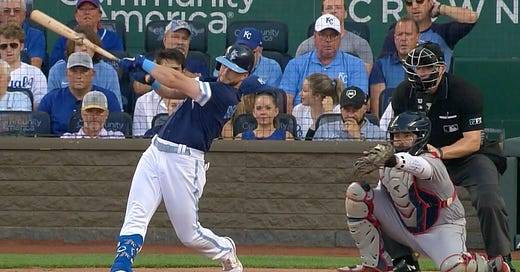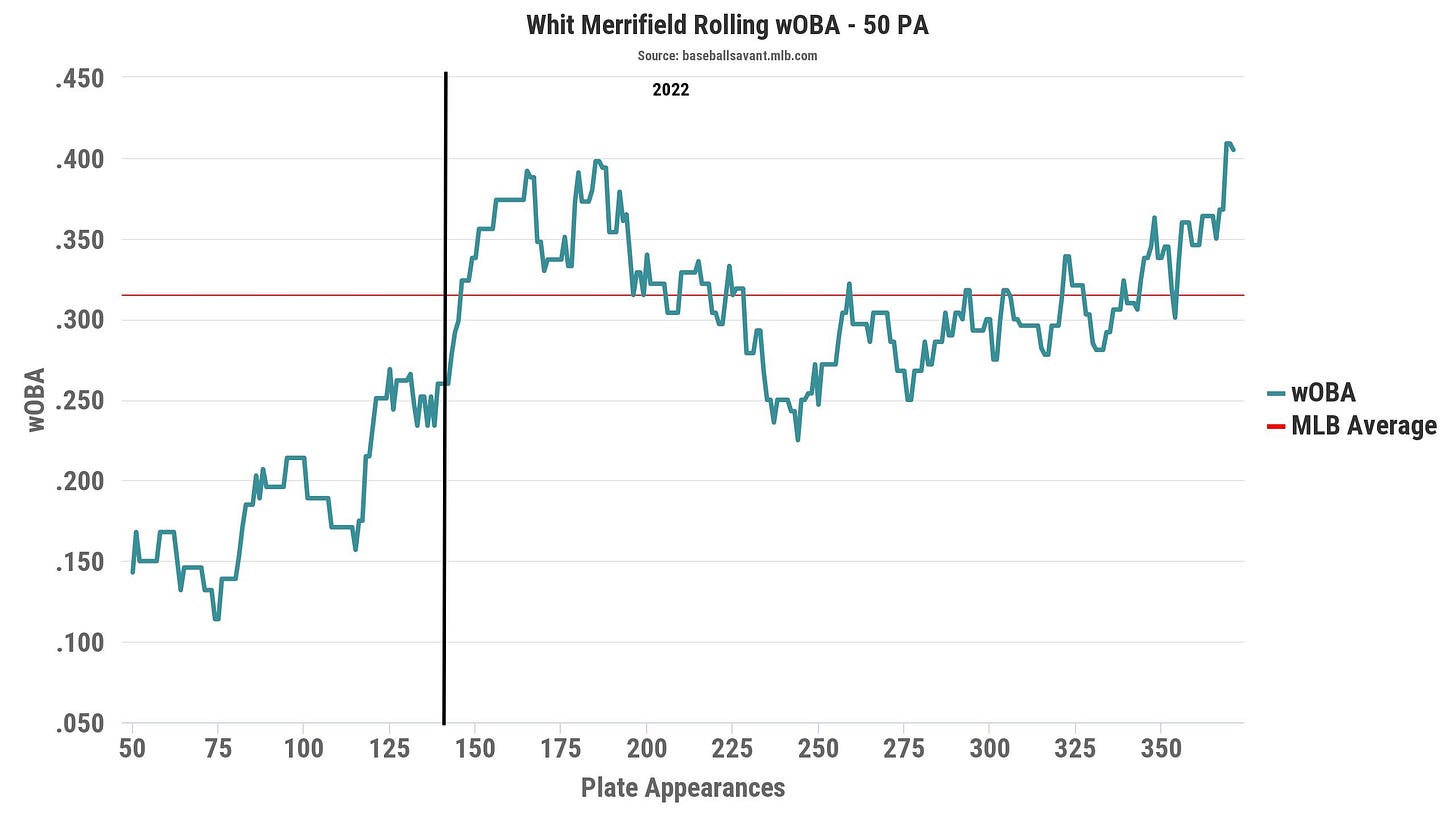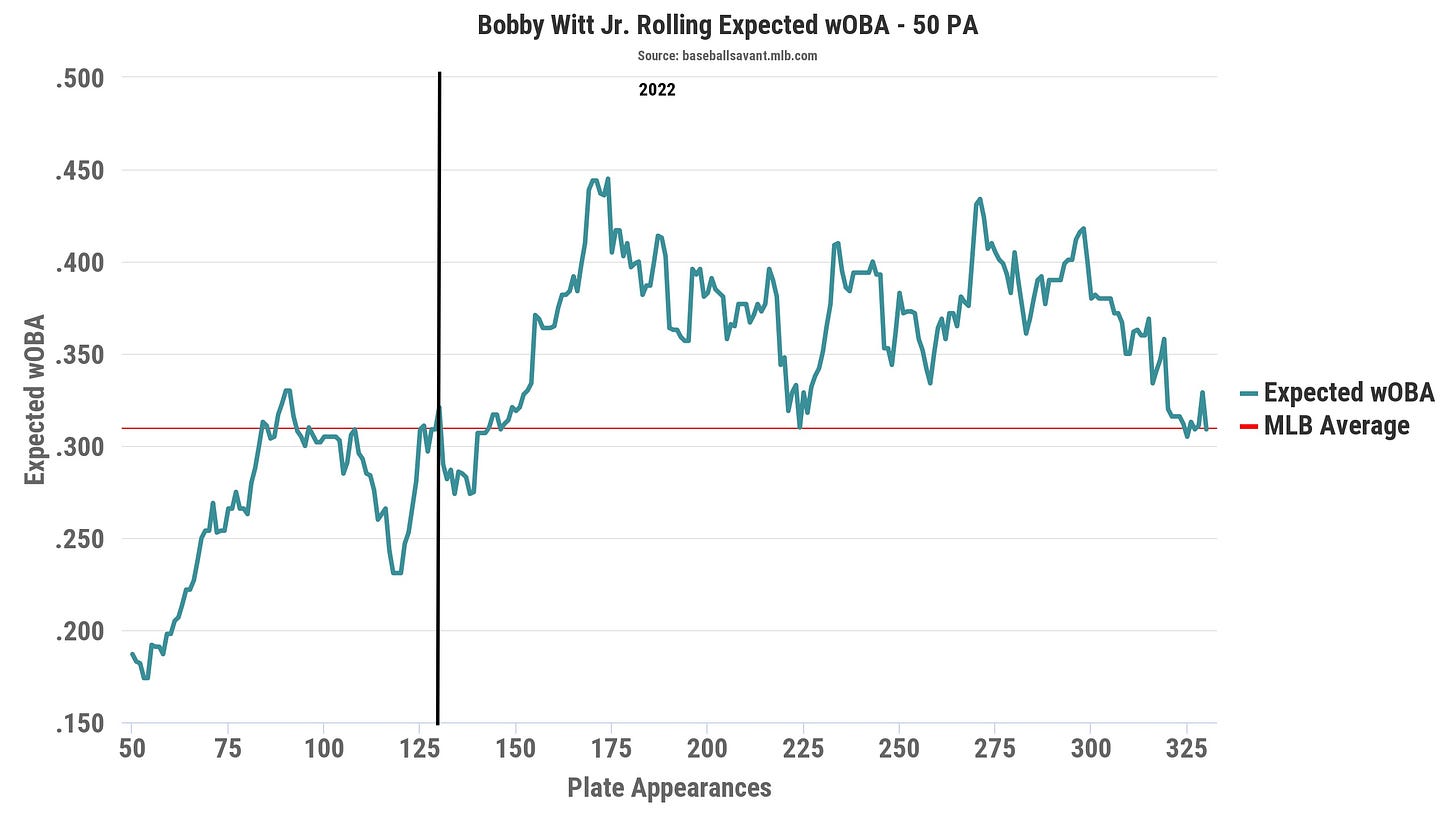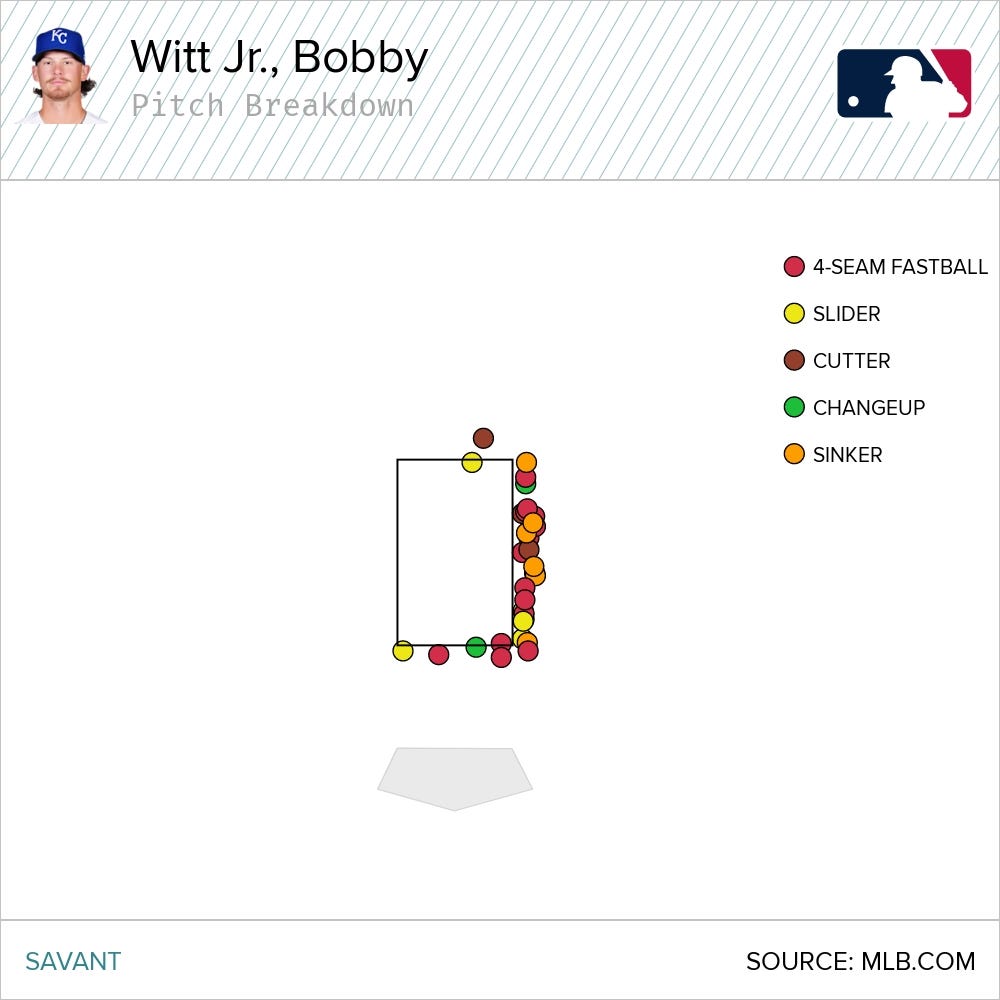Halfway home: The hitting
The improvements in hitting since changing hitting coaches is extreme. It can provide a blueprint for how to handle the pitching. If only the Royals would pay attention.
After looking at the pitching at the halfway point in the last edition of the newsletter (link here in case you want to get baseball depressed all over again), it’s time to shine a light on the hitting.
In a strange way, what’s going on with the bats, only underscores the issues with the pitching. On May 16, the Royals parted ways with hitting coach Terry Bradshaw and added Alec Zumwalt and Mike Tosar to the dugout staff. Together with holdover Keoni DeRenne, the trio has rejuvenated the team’s offense.
Is rejuvenated a strong enough word? Mercy. This is a different team. Almost 40 points added to the on-base percentage, 70 points of improvement in slugging…They were 23 percent worse than the league average offense and now they’re five percent better? These three hitting wise men are working some kind of offensive miracle.
This isn’t rocket science? Identify an area where your club is struggling and has the potential to do better and make the necessary changes. See what happens? Obviously, it’s not always guaranteed to work, but if changing a hitting coach a little over a month into a season can yield these kinds of results with an offense that was underachieving, I wonder what a change at pitching coach could do when you have a lot of potential young, live arms on the roster.
But I digress…
This entry is about the hitting. And the Royals, while not exactly setting the league on fire with the lumber, have been productive at an above-average level since the bump of Zumwalt and Tosar to the dugout. The change has been so thorough and complete, that I doubt it’s a coincidence. Nearly every hitter has improved since mid-May. Most are providing solid, above-average production at the plate. As a result, the Royals have been scoring more runs. They were averaging 3.7 runs per game with Bradshaw in charge of the hitters. With Zumwalt and company, the Royals are scoring 4.1 runs per game.
While there is still work to be done on the offensive side, the improvement is marked. Let’s break down some of the individual hitters who worked with both Bradshaw and Zumwalt over the first half of the season.
Whit Merrifield
Ah, yes…We lead off with Two-Hit Whit! Nobody has improved more than Merrifield.
I’m loath to explain his resurgence solely on the change at hitting coach if only because Merrifield was so awful over the first month-plus of the season that he really had nowhere to go but up. Nevertheless, it’s been a nice rebound that illustrates that, while he’s not all the way back to where you would think he should be at this point of the season, he’s clearly made strides.
Still, this chart is insane. The black vertical line is May 15.
Merrifield has begun to claw his way out of the offensive doldrums before Bradshaw was fired, but kicked on the afterburners on May 16.
Overall, his wRC+ is in the upper 70s. Can he continue to make a push to get to above 90, which would represent an improvement over 2021 and perhaps convince us that he’s going to be able to keep that pesky decline that comes with age at bay for at least another year? The good news is his hard-hit rate and average exit velocity are better than they’ve been since 2018. If he can just hit a few more line drives (currently at 25 percent of batted balls, a career-low rate) he could recapture just a little bit of that magic.
He left Sunday’s game with a toe injury. We’ll have to see what that means. Although it would be so Royals for them to lose a player like Merrifield, who’s played in 553 consecutive games, to an injury just ahead of the trade deadline.
Andrew Benintendi
ESPN’s Jeff Passan says the market for the Royals left fielder is “off the charts.” And from the numbers above, you can see why demand is high for the Royals’ lone All-Star representative.
Benintendi was scorching hot over the first month-plus of 2022. He’s been better since then.
Here’s the issue. The way the Royals’ offense has been humming with Benintendi hitting second, removing him would clearly make the lineup weaker. They’re going to score fewer runs, and with the state of the pitching…That’s going to nudge them to the wrong side of 100 losses. However, you know and I know and everyone with a shred of baseball sense knows that the Royals need to trade Benintendi. But will the front office pull the trigger when that’s going to clearly cause the Royals to lose more games?
It’s a dumb question, but one that needs to be asked given the statements coming from One Royal Way. Still, I think the Royals make a deal, if only because the volume of calls will increase to a total cacophony over the next couple of weeks. They better get a haul.
Benintendi’s power production is way down. He’s rocking a .085 ISO after posting a .154 career ISO. That would be a problem, but we know power isn’t really Benny’s game. He’s added so much on-base ability that he’s transformed himself into a guy who should slot into the leadoff spot. I’ll take him at the number two since there doesn’t seem to be any way Mike Matheny will move Merrifield out of the top of the lineup card. If Benintendi continues to maintain his .387 OBP, it would be the best of his career by over 20 points.
Bobby Witt Jr.
Can we surmise that Witt was probably the main reason the move to sack the hitting coach was made? Even if the Royals didn’t expressly say so, it just kind of makes sense. The prospect is completely familiar with Zumwalt’s teaching and methodology and while Witt clearly has loads of talent, has been one of the primary benefactors. If Bradshaw wasn’t able to communicate the organizational philosophy developed by Zumwalt, that could potentially have a negative impact on the wave of prospects we’re currently seeing.
While Witt’s splits above are profound, it should be noted that he started to find his groove after about 10 to 15 games of his first taste of major league pitching. Let’s give him the same chart we did for Merrifield’s rolling wOBA from Baseball Savant. Again, the black vertical line is when the hitting coach change was made.
The next phase of Witt’s development needs to be about plate discipline. His overall 5.8 percent walk rate is far too low. He needs to bump it to closer to nine percent—the rate he posted in both Double and Triple-A last summer. If he can do that, his offense edges close to elite.
To be fair, early in the season it sure felt like the home plate umps were giving Witt a bit of a wide “prospect” zone. Overall this year, Witt has taken a called strike on 2.7 percent of pitches he’s seen outside the zone according to data collected at Baseball Savant.
That’s tied for 27th most out of 157 hitters who have seen at least 1,000 pitches this year. That’s quite a bit. And the highest on the Royals. Which is maybe why it seems to stand out.
Hunter Dozier
Of the regulars who saw playing time under both hitting coaches, only Dozier hasn’t improved. But given how little he’s dropped since his start, that’s just nitpicking.
If you harken back to Dozier’s 2019 (aka the best year of his career), you can see that he hit for a bit more power (with a .243 ISO compared to a .176 this year) and walked more often (with a 9.4 percent walk rate compared to a 7.5 percent rate this summer). Still, given the direction offenses are trending the last few seasons, he’s representing with a performance that checks in at well above average.
Dozier is hitting more ground balls this year than he ever has and his hard-hit rate is also a career-low at 28 percent. According to Baseball Savant, his hard-hit rate drops him in the 49th percentile. If I were to bet on a batter in this lineup to regress from the first half, it would be Dozier.
Michael A. Taylor
This table absolutely blows my mind.
For me, Taylor’s 2022 season is the most intriguing of all Royals hitters. His overall walk rate was at 10.5 percent over the first half of the season, about three and a half points above his career rate. Just an unheard of transformation of plate discipline at this stage of his career. His strikeout rate has dipped to around 24 percent, almost six points below his career average. If the season ended after these 81 games, his 112 wRC+ would mark just the second time in his career he was an above-average hitter…and it would be the best year of his career. At the age of 31.
Taylor is one of those guys who usually has a BABIP well over the alleged marker of .300. In fact, his career BABIP is .326. Since Zumwalt and company took over, Taylor is mashing at an incredible (and unsustainable, even for him) .406 BABIP. The walk rate is down and the strikeouts are up since May 15 as well. He’s actually settled into to an area where we’d expect him to be over about the last month.
Goodness, he was blistering the baseball when he returned from the Covid IL in early June. That lasted for a couple of weeks and it’s that performance that’s carrying his numbers in the Zumwalt era.
While he’s providing great value in the bottom third of the order for the Royals, they would be smart to shop him aggressively over the next couple of weeks. Zumwalt may work miracles, but the clock is racing toward midnight here.
Nicky Lopez
What happened? I feel like we’ve kind of glossed over his season. Not that expectations were super-high, but after what we saw in 2021, they were a bit elevated.
He’s walking less than in 2021, which has certainly impacted his OBP. The real story, however, is his struggles with off-speed pitches. Last year, he hit .297 against off-speed offerings, according to Baseball Savant. This year? Lopez is hitting just .063. It’s not as if you can chalk that down to bad luck. It’s pitch recognition. This year, Lopez has struck out 11 times in 33 plate appearances ending with an off-speed pitch. He whiffed nine times in 68 PAs last year. Let’s see if Zumwalt and company can fix that in the season’s second half.
I realize I’ve left out prospects such as MJ Melendez, Emmanual Rivera and Vinnie Pasquantino. All three have received considerable playing time, but weren’t around or had limited exposure to the old hitting regime. Salvador Perez has been injured and attempted to hit through his thumb injury, so I decided to leave him out as well.
Rivera has been solid, if unspectacular, at the plate. Melendez continues to deliver some kind of quality plate appearances and sported a wRC+ of 108 over the season’s first half. We haven’t seen enough of Pasquantino at the major league level to make any proclamations, but he certainly has folk hero potential. And he hits the snot out of the baseball. If Matheny can see his way to stack Witt Jr., Pasquantino and Melendez in the middle of the lineup with consistency, that feels like something we can all get excited about. Especially with Zumwalt, DeRenne and Tosar in the dugout as the three-headed hitting guru.
I’m much more bullish on the Royals’ hitting than I am on the pitching. We’re seeing the results from the influx of young hitters and the philosophies honed in the minor leagues making their way to the big league club. If Dayton Moore and JJ Picollo could get beyond the great attitude of the pitching coach and decide to truly hold someone accountable for the disaster of the first half, this team could start to build a serious foundation.
For now, we’ll just have to live with the improvements on the hitting side.
How about a bonus entry?
Carlos Santana
He’s busy hitting dingers in Seattle, but I would be interested in hearing from, if he were so inclined, Carlos Santana.
He joined the Royals coming off a poor 2020 season, got off to a decent start in 2021, but eventually faded. We were told his strained hip flexor submarined the second half of his season, but the results clearly weren’t there in the first few weeks of 2022. The difference between hitting coaches is extremely pronounced in his case. Is it a coincidence? A player finally progressing to the mean? Or was the change in coaches just what he needed? Only Santana can say for sure.
If Wyatt Mills or William Fleming turn into anything for the Royals, maybe we can give Zumwalt and company some indirect credit for improving the pitching. Is there anything these guys can’t do?



















Scoring runs seems to be something we can all support - making that change in staff produced results...what a crazy idea...
Great summary Craig. Really enjoyed it.
Will be interesting to see, with all these coaches up here at the ML level, who is in charge of teaching their philosophy in the minors now? Will they all still stay on the same page?